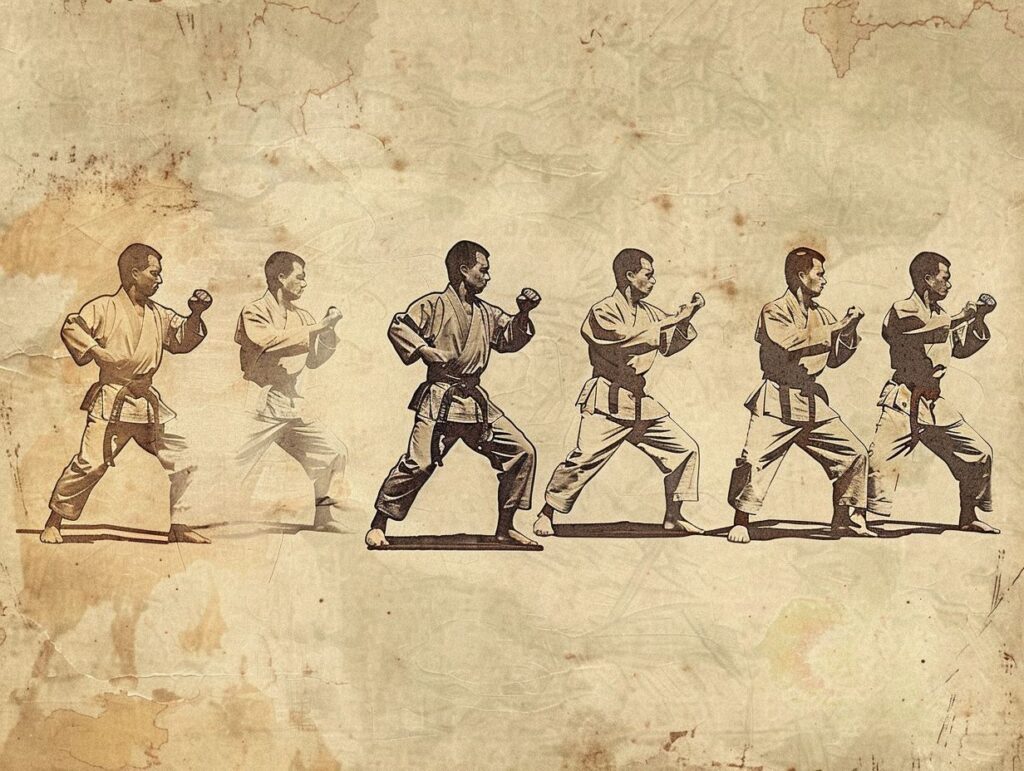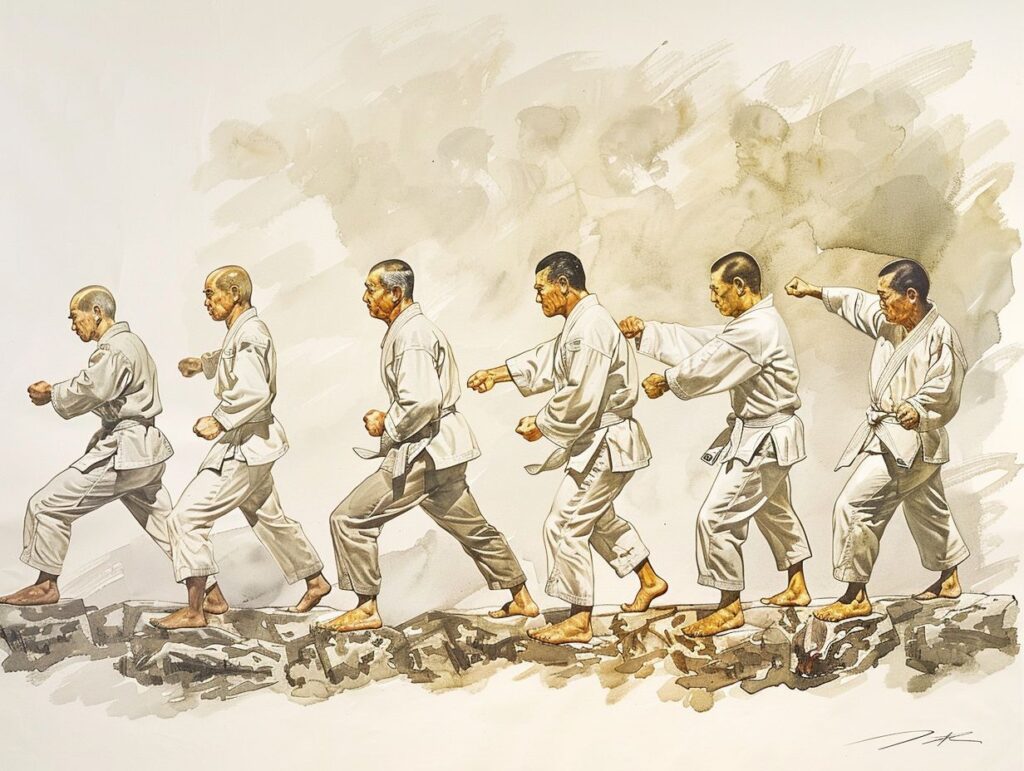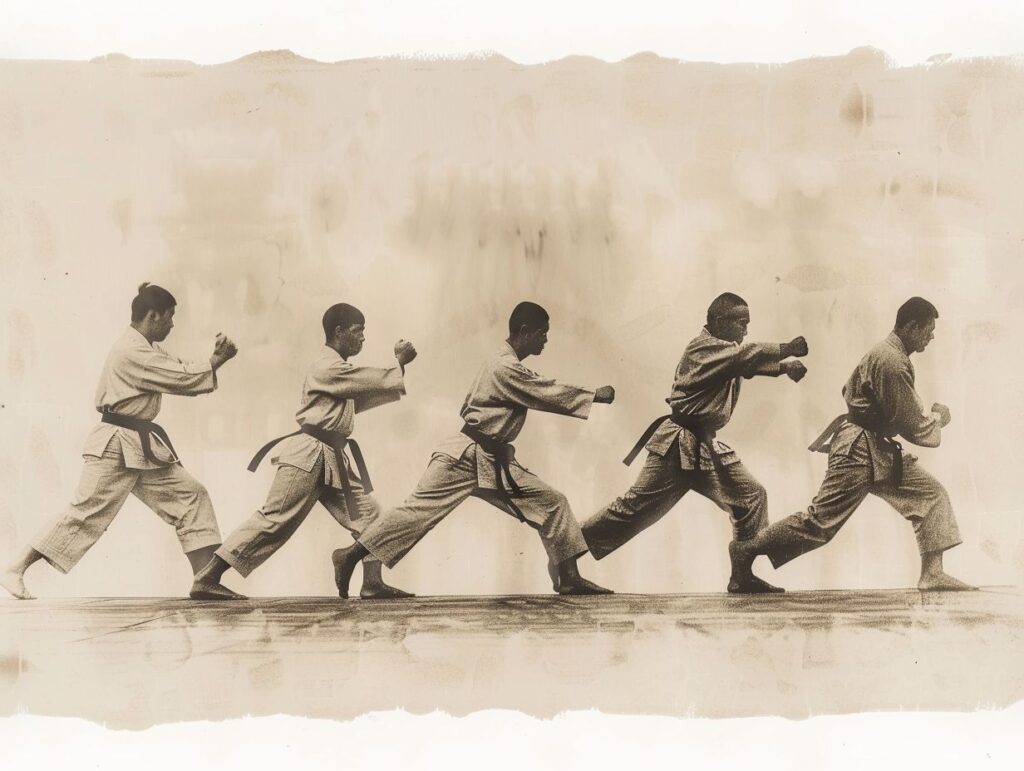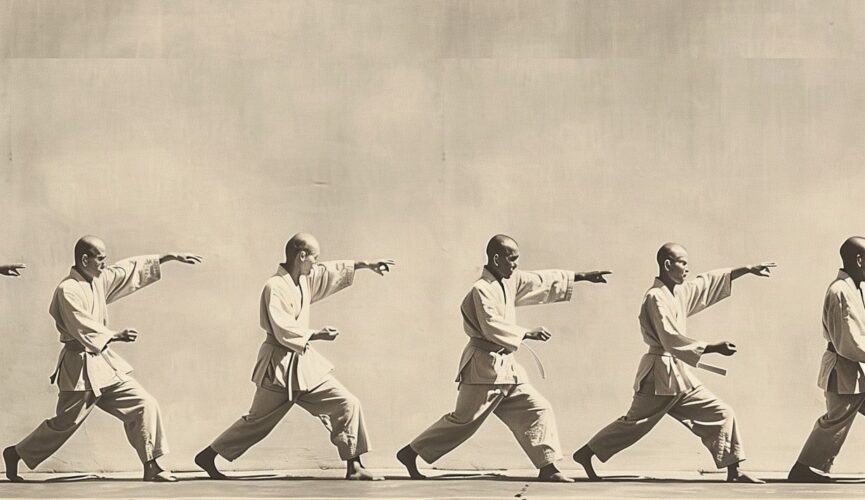If you’re into martial arts, you’ve probably heard of Kyokushin Karate. It’s all about intense physical conditioning and going full throttle in sparring sessions. This martial art has a pretty cool history that goes way back. It all started with the legendary founder, Masutatsu Oyama, and from there, it spread worldwide with some modern training techniques thrown in the mix.
You’ll dig into the core principles and philosophy of Kyokushin Karate, which were influenced by Zen Buddhism and other martial arts. Plus, you’ll get to know the big names who’ve made a mark on this discipline. And don’t forget to explore how Kyokushin Karate has left its mark on other martial arts and even pop culture.
Origins of Kyokushin Karate
The origins of Kyokushin Karate can be traced back to Japan, where martial artist Masutatsu Oyama laid the foundation for this full-contact fighting style. It all started in the mid-20th century when Oyama established Kyokushin Karate and eventually gained global recognition with the formation of the International Karate Organization.
You know, Masutatsu Oyama was quite the legend with his remarkable power and skill, and he played a key role in shaping the core principles of Kyokushin Karate. Drawing from his own life experiences, Oyama aimed to create a martial art that focused on physical, mental, and spiritual growth. This unique approach set Kyokushin Karate apart from other traditional styles of that era. By setting up the International Karate Organization, Oyama opened doors for the worldwide propagation and advancement of this demanding discipline. The roots of Kyokushin Karate run deep in the history of Japanese martial arts, blending ancient traditions with contemporary combat techniques.
Founder and Early Development
You should know that Masutatsu Oyama, also known as Mas Oyama, created Kyokushin Karate as a tough discipline that mixes hardcore physical training, powerful techniques, and a philosophy grounded in discipline and respect. Oyama set up dojos where you could dive into intense full-contact training, fully embracing the Kyokushin philosophy.
This training approach doesn’t just focus on physical strength; it’s all about mental toughness too. Oyama believed that mastering karate meant having a robust mind along with a strong body. By sticking to rigorous practice and discipline, you’re challenged to go beyond your limits and unleash your full potential. Oyama’s incorporation of Ashihara Karate principles into Kyokushin training not only boosted technique effectiveness but also gave students a deeper insight into combat dynamics.
Key Principles and Philosophy
In Kyokushin Karate, you immerse yourself in the philosophy of Budo, where discipline, respect, and inner strength take center stage. As a practitioner, you live by a code of conduct that embodies the spirit of Osu, emphasizing honor and respect for both yourself and others.
The discipline you cultivate in Kyokushin Karate goes far beyond just physical training; it delves into mental toughness and emotional resilience. This martial art is all about mastering yourself, pushing your limits physically and mentally. Through intense training and unwavering commitment, you learn to conquer challenges with grit and humility.
The spirit of Osu is at the heart of Kyokushin Karate, urging you to tackle obstacles with a positive attitude and to always show respect to your opponents and mentors.
Influence of Zen Buddhism and Other Martial Arts
In Kyokushin Karate, you’ll find inspiration from Zen Buddhism. This martial art blends meditation, traditional karate techniques, and breathing exercises to boost your mental focus and readiness for combat. By weaving these elements together, Kyokushin Karate taps into both the spiritual and physical aspects of training.
This unique mix isn’t just about sharpening your fighting skills. It’s also about nurturing your inner calm and awareness. Kyokushin Karate teaches you to stay present in the moment, helping you harness your energy more effectively in both practice and competitions.
The meditative side of Zen Buddhism brings mental clarity and a deeper connection to your body and mind. This deeper understanding translates to better control over your physical movements and emotional reactions. And let’s not forget about the breathing exercises in Kyokushin Karate – they’re not just about building endurance and stamina. They also work wonders for promoting relaxation and reducing stress.
Spread and Evolution of Kyokushin Karate

As you explore the world of Kyokushin Karate, you’ll see how it has spread far beyond its origins in Japan, captivating practitioners worldwide with its demanding routines, impactful moves, and focus on physical fitness.
This global journey of Kyokushin Karate has opened doors to blending diverse training techniques and cultural viewpoints, adding layers of depth to the art’s methods and beliefs on a worldwide scale. With every new corner of the globe it reaches, different countries infuse their own traditional martial arts styles into Kyokushin practice, creating a vibrant mix of tactics and mindsets that leave a lasting mark on fighters everywhere.
International Expansion and Branches
As you dive into the world of Kyokushin Karate, you’ll find branches popping up all over the globe, each one celebrating the core disciplines and warrior spirit of this martial art. The headquarters of Kyokushin Karate, known as Kyokushinkaikan, stands tall as a symbolic hub for practitioners worldwide.
As you explore the expanding network of Kyokushin Karate dojos in different countries, you’ll encounter dedicated individuals committed to the art’s tough training methods and focus on physical and mental strength. The global web of dojos reflects a steadfast dedication to Kyokushin’s founding values of humility, respect, and perseverance. Kyokushinkaikan, serving as the central hub, not only offers guidance and encouragement but also ensures the preservation of the authentic techniques and values that define this esteemed martial art.
Major Figures in Kyokushin Karate
You’ve got to check out Kyokushin Karate – it’s got big names like Karate masters and leaders such as Sosai Masutatsu Oyama. Their legacy lives on through places like the Masutatsu Oyama Memorial Museum. These influential folks have really shaped how Kyokushin Karate has grown and spread across the world.
They’re all about perfecting the art and passing on important values like discipline, perseverance, and respect. That’s why people from all around have been drawn to Kyokushin Karate. Thanks to their teachings and demos, they’ve motivated tons of folks to dive into the world of martial arts and strive for excellence. These legends haven’t just made Kyokushin Karate known worldwide – they’ve also built a tight-knit community and sense of camaraderie in the martial arts realm.
Notable Masters and Competitors
In the realm of Kyokushin Karate, you’ll find notable masters and competitors who have emerged, training dedicated students like yourself who are progressing through the rigorous ranking system to achieve that coveted black belt. These skilled individuals showcase their expertise in high-profile tournaments, embodying the essence of Kyokushin Karate.
But it’s not just about technical prowess; these experienced figures also instill in their students, like you, the core values of discipline, perseverance, and respect that are crucial to the practice of Kyokushin Karate. When you finally earn that black belt after years of training and dedication, it’s not just a symbol of technical proficiency but also a sign of your deep understanding of the art’s philosophy.
When you step into those tournaments, it’s not just about testing your skills; it’s about adding to the competitive landscape of Kyokushin Karate and inspiring the next generation of practitioners, like you, to strive for excellence.
Modern Practices and Training Methods

In modern Kyokushin Karate, you are encouraged to follow structured training routines that blend hardcore physical conditioning, mental exercises, and mastering basic techniques like kicks, strikes, and blocks. The goal of these up-to-date methods is to level up your combat skills and boost your resilience.
Kyokushin Karate’s training techniques have evolved to focus on your overall growth, not just physical strength. The training now emphasizes mental toughness, incorporating meditation, breathing exercises, visualization techniques, and tough physical workouts. The aim is to shape you into a more complete martial artist.
When you focus on perfecting your powerful kicks, precise strikes, and solid blocks, you prepare yourself better for the tough demands of real combat. By combining physical and mental training, you gain a deeper insight into strategy, timing, and control, helping you reach martial arts excellence.
Emphasis on Full Contact and Physical Conditioning
In Kyokushin Karate, you’ll find a strong emphasis on full-contact sparring and tough body conditioning. This approach is all about building strength, fitness, and endurance in those who practice it. The intense training involved in full-contact sparring helps to strengthen both your mind and body as a Kyokushin Karateka.
When you dive into full-contact sparring, you get the chance to put your techniques to the test and adapt quickly under pressure. This hones your reflexes and strategic thinking skills. The rigorous body conditioning routines, like heavy bag work and strength training, don’t just pump up your muscles but also toughen up your mental game. By tackling these physical and mental challenges head-on, you’ll push yourself beyond your limits and cultivate a strong sense of perseverance. All these elements in Kyokushin Karate work together to shape individuals who are not only physically strong but also able to bounce back from adversity with resilience.
Impact and Legacy of Kyokushin Karate
When you dive into the world of Kyokushin Karate, you’re not just signing up for self-defense and combat sports – you’re stepping into a realm that focuses on offensive techniques and your personal growth. This martial art’s influence goes beyond the dojo, emphasizing the warrior spirit and continuous self-improvement.
In Kyokushin Karate, the full-contact style isn’t just about throwing punches – it’s about building mental toughness, discipline, and resilience. By gritting your teeth through grueling training sessions and pushing yourself in hard-hitting sparring matches, you’re not just improving your physical strength – you’re also forging a rock-solid mindset that can help you tackle life’s challenges. Through the core values of perseverance and respect, Kyokushin Karate teaches you to face obstacles head-on with determination and the willingness to break boundaries, nurturing a well-rounded approach to personal development.
Influence on Other Martial Arts and Pop Culture
You can see the influence of Kyokushin Karate all over the place, from other martial arts to pop culture. The tough combat training and emphasis on striking techniques, along with that warrior spirit vibe, have really left their mark. It’s like Kyokushin’s combat techniques and philosophies have seeped into all kinds of areas, shaping the world of martial arts in a big way.
Other martial arts have taken a page from Kyokushin’s book, incorporating its training methods and combat strategies. The full-contact sparring and conditioning focus in Kyokushin has made its way into disciplines like MMA and kickboxing, giving fighters that extra edge in endurance and toughness. And that warrior spirit? Filmmakers and writers have been all over it, featuring Kyokushin Karate in movies and literature. It’s like Kyokushin has really solidified its spot in popular culture.
Frequently Asked Questions

What is the history of Kyokushin Karate?
Kyokushin Karate was founded by Masutatsu Oyama in 1964 in Japan. It is a full-contact style of Karate that focuses on physical and mental training, with the goal of developing a strong spirit and body.
Who is the founder of Kyokushin Karate?
Masutatsu Oyama is the founder of Kyokushin Karate. He was born in 1923 in South Korea and traveled to Japan to study martial arts. He combined elements from various styles to create Kyokushin, which means “ultimate truth”.
When was Kyokushin Karate introduced to the world?
Kyokushin Karate was introduced to the world in 1957 when Masutatsu Oyama held his first public demonstration. It gained popularity in the 1960s and has since spread to over 140 countries, making it one of the largest and most influential martial arts styles.
What makes Kyokushin Karate unique?
Kyokushin Karate is known for its intense physical training and full-contact sparring. It also emphasizes the development of mental strength, discipline, and a strong moral code. The use of open-handed strikes and low kicks are also distinguishing features of this style.
What role did Masutatsu Oyama play in the growth of Kyokushin Karate?
Masutatsu Oyama was instrumental in spreading Kyokushin Karate around the world. He not only taught and trained students but also organized tournaments and demonstrations to showcase the effectiveness of the style. He also wrote books and created training methods that are still used today.
How has Kyokushin Karate evolved over time?
Since its inception, Kyokushin Karate has continued to evolve and grow. In the 1970s, Masutatsu Oyama introduced the concept of “knockdown” sparring, which involved full-contact fighting with protective gear. In recent years, Kyokushin has also incorporated elements from other martial arts, such as grappling and ground fighting.

